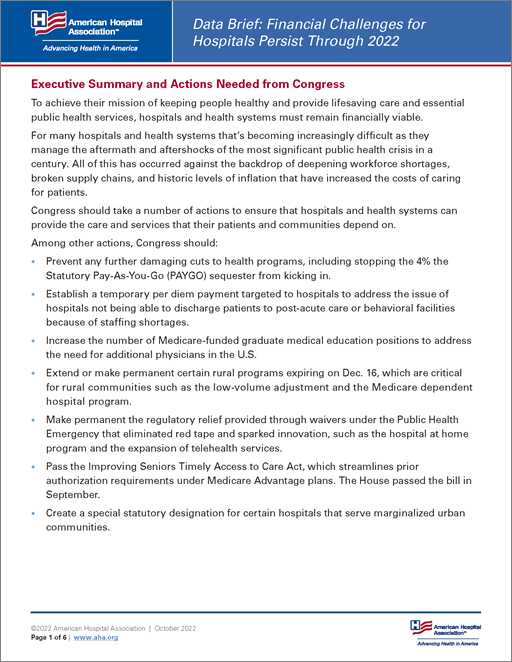Data Brief: Financial Challenges for Hospitals Persist Through 2022
Executive Summary and Actions Needed from Congress
To achieve their mission of keeping people healthy and provide lifesaving care and essential public health services, hospitals and health systems must remain financially viable.
For many hospitals and health systems that’s becoming increasingly difficult as they manage the aftermath and aftershocks of the most significant public health crisis in a century. All of this has occurred against the backdrop of deepening workforce shortages, broken supply chains, and historic levels of inflation that have increased the costs of caring for patients.
Congress should take a number of actions to ensure that hospitals and health systems can provide the care and services that their patients and communities depend on.
Among other actions, Congress should:
- Prevent any further damaging cuts to health programs, including stopping the 4% the Statutory Pay-As-You-Go (PAYGO) sequester from kicking in.
- Establish a temporary per diem payment targeted to hospitals to address the issue of hospitals not being able to discharge patients to post-acute care or behavioral facilities because of staffing shortages.
- Increase the number of Medicare-funded graduate medical education positions to address the need for additional physicians in the U.S.
- Extend or make permanent certain rural programs expiring on Dec. 16, which are critical for rural communities such as the low-volume adjustment and the Medicare dependent hospital program.
- Make permanent the regulatory relief provided through waivers under the Public Health Emergency that eliminated red tape and sparked innovation, such as the hospital at home program and the expansion of telehealth services.
- Pass the Improving Seniors Timely Access to Care Act, which streamlines prior authorization requirements under Medicare Advantage plans. The House passed the bill in September.
- Create a special statutory designation for certain hospitals that serve marginalized urban communities.
View the detailed brief below.


